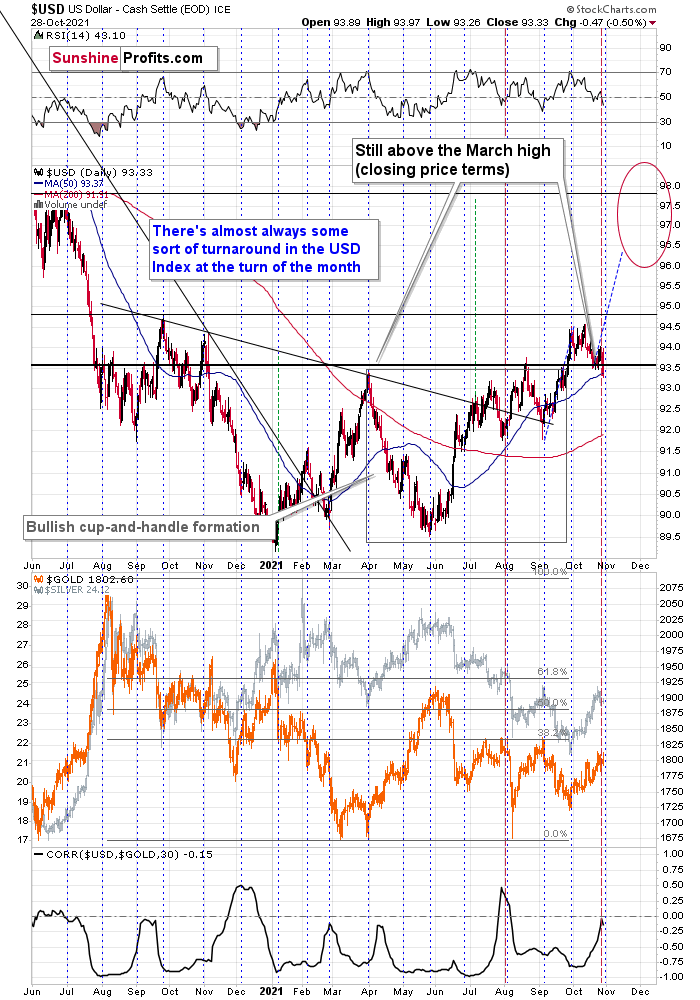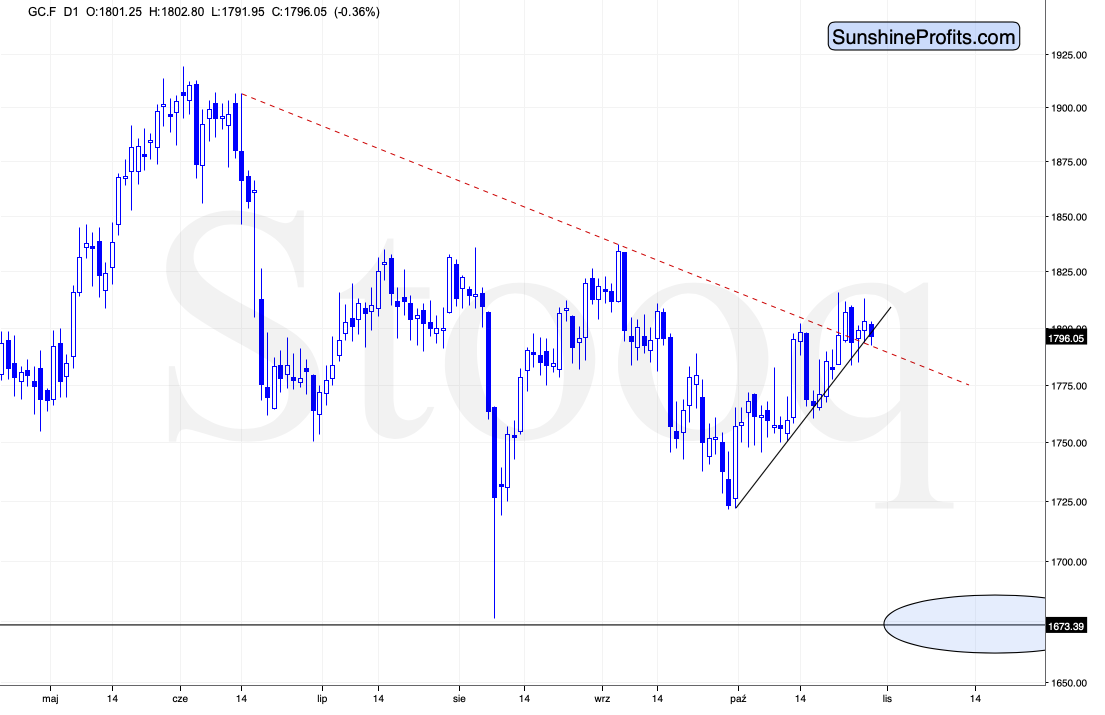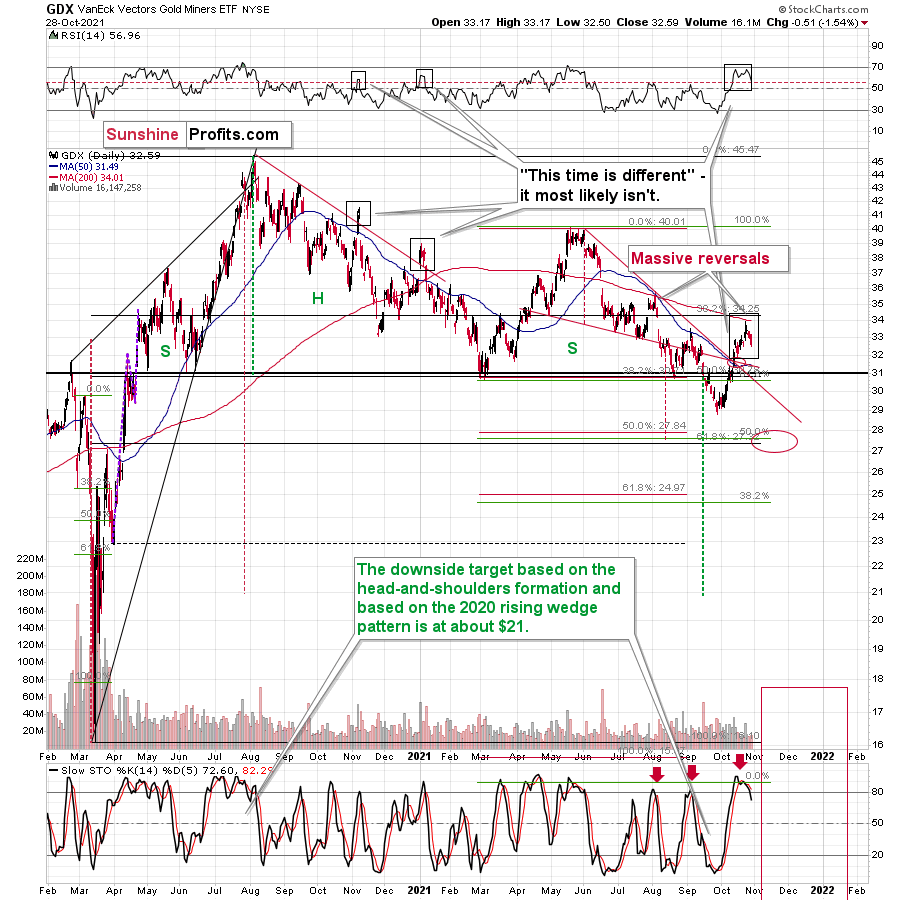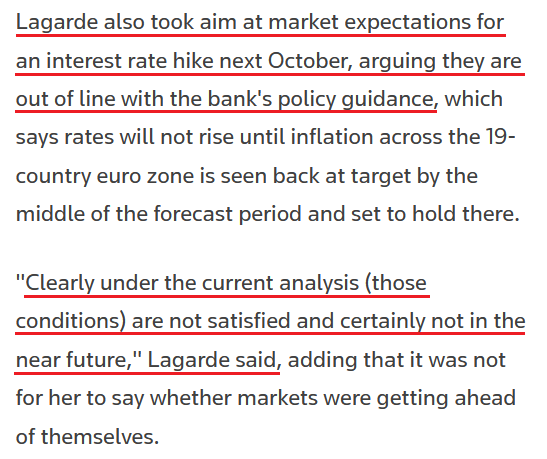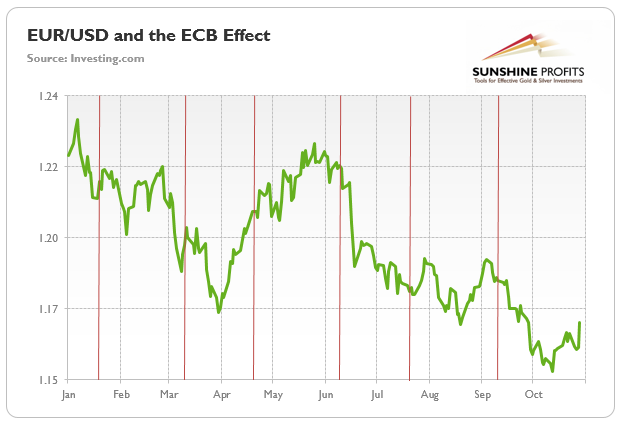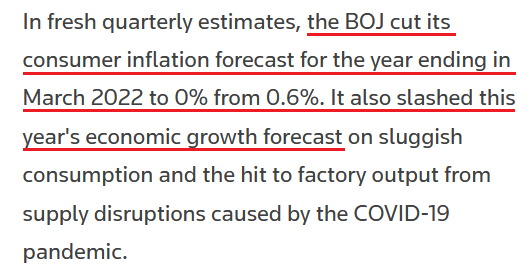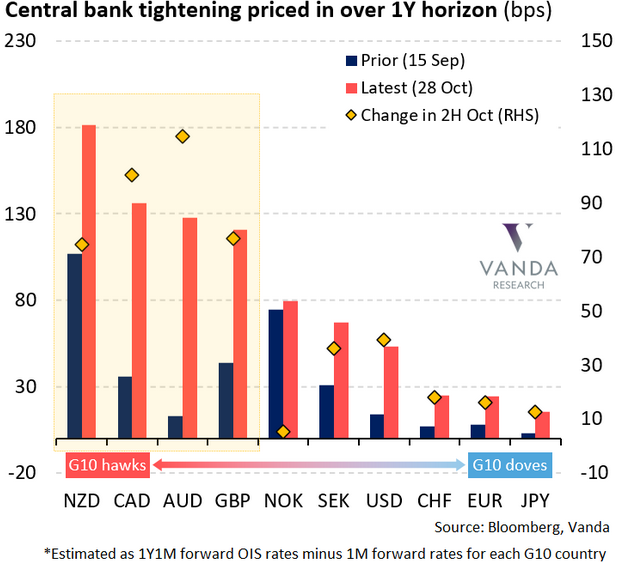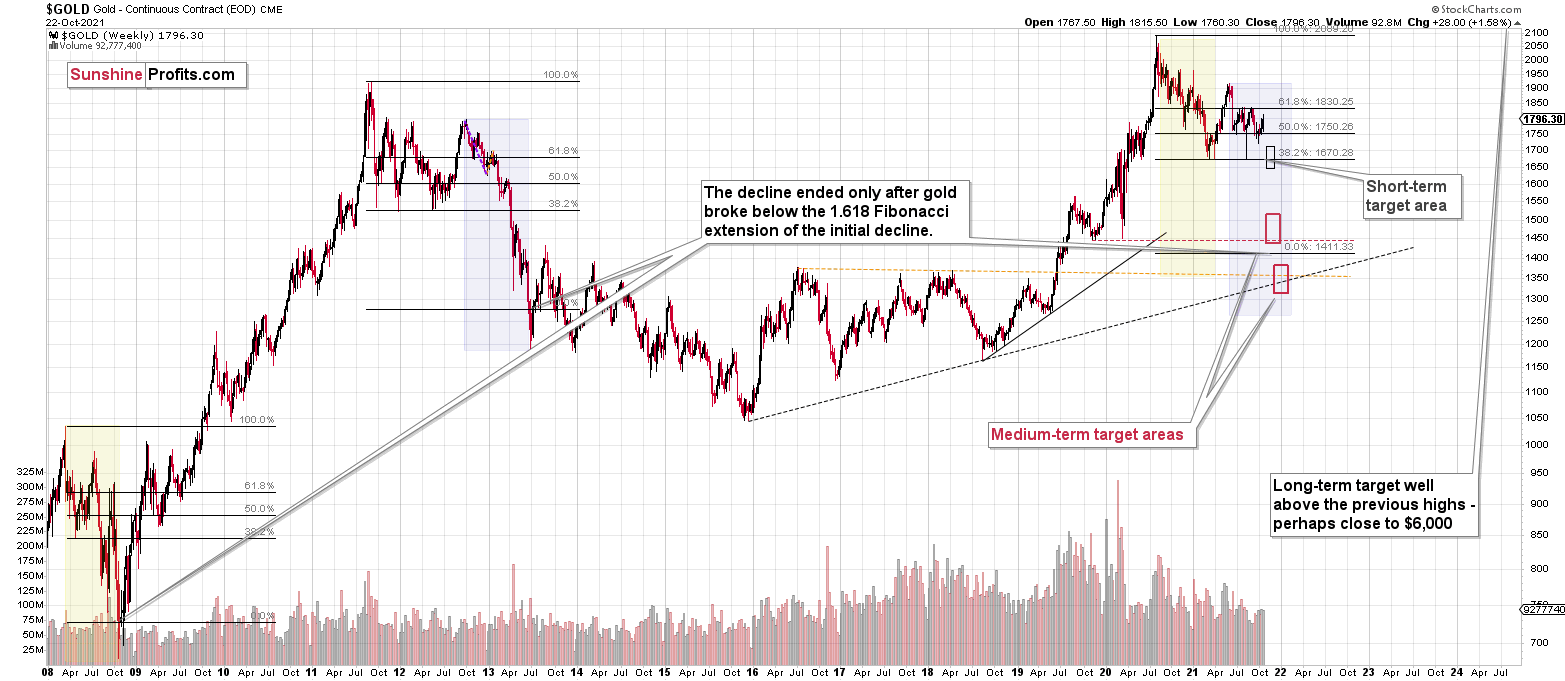Briefly: in our opinion, full (300% of the regular position size) speculative short positions in junior mining stocks are justified from the risk/reward point of view at the moment of publishing this Alert.
After no significant action for a few days, something really interesting (finally!) happened in the markets. The trigger was quite random (Lagarde’s rather uninformative comments during a press conference; I’ll comment on that later today), but the way in which markets reacted was profoundly informative.
First Things First
I received a few questions about the situation in the USD Index, so let’s start today’s technical part with it.
Based on the rather random comment during the conference, the traders panicked and bought the EUR/USD, which triggered declines in the USD Index (after all, the EUR/USD is the largest component of the USDX).
Was the breakout to new 2021 lows invalidated? No. The true breakout was above the late-March highs (the August highs also served as a support level, but the March high is more important here) and it wasn’t invalidated.
What was the follow-up action? At the moment of writing these words, the USDX is up and trading at about 93.52, which is just 0.07 below the August high in terms of the closing prices. Consequently, it could easily be the case that the USD Index ends today’s session (and the week) back above this level.
You’ve probably heard the saying that time is more important than price. It’s the end of the month, so let’s check what happened in the case of previous turns of the month; that’s where we usually see major price turnarounds. I marked the short-term turnarounds close to the turns of the month with horizontal dashed blue lines, and it appears that, in the recent past, there was practically always some sort of a turnaround close to the end of the month. Consequently, seeing a turnaround (and a bottom) in the USD index now would be perfectly normal.
Moreover, please note that despite USD’s sizable daily decline, gold was barely up. This is not a bullish type of reaction for the PMs, but a bearish one.
While the price of gold moved higher yesterday, please note that yesterday’s turnaround took place at the triangle-vertex-based reversal, and the fact that we saw another intraday reversal makes the current situation even more similar to what we saw in early August before the sizable slide.
Just a little more weakness and we’ll see a short-term breakdown that could take gold much lower very quickly.
Yesterday’s price action in gold stocks confirms this scenario.
Even though gold ended the day slightly up, the mining stocks (GDX) were down by over 1.5%. In yesterday’s analysis, I emphasized that the days of miners’ strength relative to gold are likely numbered. Yesterday’s performance appears to confirm that and thus the next downswing seems to have already begun.
Having said that, let’s take a look at the markets from a more fundamental point of view.
Hear What They Want to Hear
With the EUR/USD rallying sharply on Oct. 28, the ECB must have accelerated the hawkish rhetoric, right? Well, in reality, the ECB maintained its dovish stance and the fundamental outlook for the EUR/USD remains unchanged. To explain, the ECB’s monetary policy statement reiterated the same old message:
“The Governing Council will continue to conduct net asset purchases under the PEPP with a total envelope of €1,850 billion until at least the end of March 2022 and, in any case, until it judges that the coronavirus crisis phase is over.”
And:
“Net purchases under the APP will continue at a monthly pace of €20 billion. The Governing Council continues to expect monthly net asset purchases under the APP to run for as long as necessary to reinforce the accommodative impact of its policy rates, and to end shortly before it starts raising the key ECB interest rates.”
Despite that, though, investors zeroed in on ECB President Christine Lagarde’s offhanded response during her press conference. When asked if market participants were overeager in pricing in an ECB rate hike in 2022, she said:
“Are markets ahead of themselves? Not for me to say. What I have to do and what I have to assess is the validity of our analysis, and then testing our analysis once we have determined that it was correct against the conditions for our forward guidance.”
And that’s all it took. With the ECB chief failing to vehemently push back against the futures market, her lack of reprimand was perceived as hawkish. However, despite all of the drama, Lagarde made her point loud and clear, and investors simply ran with that one fumbled statement.
For example, when asked about other central banks withdrawing stimulus, she called the comparisons to the ECB “odious.”
“The outlook is different; the level of inflation that they have is different; some of them are either at or above target already,” said Lagarde.
“Our analysis certainly does not support that the conditions of our forward guidance are satisfied at the time of liftoff as expected by markets nor any time soon thereafter. While the current phase of higher inflation will last longer than originally expected, we expect it to decline in the course of next year.”
Thus, despite the minor hiccup, Lagarde outlined the ECB’s monetary policy plans quite clearly.
Please see below:
However, because investors ‘hear what they want to hear’, and speculators do what speculators do, the EUR/USD rallied on the news. I mean, why not speculate on a euro that’s been one of the worst-performing developed market currencies versus the U.S. dollar YTD? Couldn’t it catch fire and revert to the mean?
Well, with the same merry-go-round spinning for months, I warned on May 4 that euro celebrations often end in disappointment.
I wrote:
With the EUR/USD rising on hope and falling on reality, history has shown that the latter is likely to reign supreme over the medium term.
To that point, with the currency pair down materially since then, the price action on Oct. 28 was another example of the former. However, again, with the latter “likely to reign supreme over the medium term,” lower lows should materialize once reality re-emerges.
Please see below:
To explain, the green line above tracks the EUR/USD’s movement in 2021. If you focus your attention on the vertical red lines, they mark the day before the ECB makes its policy statements. Likewise, if you analyze the performance of the EUR/USD thereafter, you can see that euro bulls often find something to celebrate when Lagarde has her press conferences.
For context, the EUR/USD has recorded rallies after five of the seven ECB policy meetings in 2021 (including on Oct. 28), declined once, and traded roughly flat after another. However, lower lows have still plagued the currency pair throughout its 2021 journey.
Thus, is this time really different?
Japan Chips In
To that point, the Bank of Japan (BOJ) also held its monetary policy steady on Oct. 28. Moreover, BOJ Governor Haruhiko Kuroda (Japan’s Jerome Powell) said that a weaker yen was “definitely positive” for the Japanese economy, and he reassured investors that the central bank would maintain its accommodative policies.
“Central banks take policies most appropriate for their economies and prices. Their decisions won't have any direct impact on Japanese monetary policy,” he said. “The yen's recent weakening, as a whole, is definitely positive for Japan's economy.”
On top of that:
Thus, with the USD/JPY and the EUR/USD combined accounting for more than 71% of the USD Index’s movement, the dollar basket’s medium-term outlook remains quite bright. Furthermore, with the Fed up next on Nov. 2/3 and U.S. inflation tracking ahead of the Eurozone, Canada, the U.K. and Japan, Powell’s days of talking down the dollar are likely over.
Please see below:
To explain, the blue (Sep. 15) and red (Oct. 28) bars above track investors’ expectations for central bank tightening over the next year. If you analyze the left side of the chart, you can see that hawkish bets on the CAD (BoC) (9.1% of the USD Index’s movement) and the GBP (BOE) (11.9% of the USD Index’s movement) have risen sharply in recent weeks.
However, if you analyze the right side of the chart, you can see that hawkish bets on the USD (Fed) are still well ahead of the EUR (ECB) and the JPY (BOJ). Again, the two currency pairs combine to account for more than 71% of the USD Index’s movement.
Furthermore, with the BoC already ending its QE program and the accelerated liquidity drain poised to help calm the country’s inflationary pressure, market participants’ hawkish bets on future rate hikes could unwind if Canadian inflation subsides.
Conversely, with the Fed reducing its bond-buying program at a slower pace (still faster than the 2013 taper and investors’ recent expectations though), sticky U.S. inflation could result in investors pricing in more rate hikes in 2022. As a result, hawkish CAD positioning seems stretched and hawkish USD positioning likely has further upside.
The bottom line? With Lagarde’s slip of the tongue overshadowing her clear and consistent position, the EUR/USD benefited from the sentiment high. However, with fundamental realities implying a sharp dove-hawk divergence between the ECB and the Fed over the medium term, the EUR/USD will likely suffer along the way. Moreover, with the BOJ eager to talk down the JPY and hawkish CAD positioning likely ahead of itself, the U.S. dollar should remain atop the currency kingdom for the foreseeable future.
In conclusion, the gold miners continued their underperformance on Oct. 28, and the price action was particularly bearish given the weakness in the USD Index. Moreover, with U.S. Treasury yields consolidating at higher lows and likely to resume their uptrends in the coming months, the PMs’ bearish thesis remains intact: the recent strength is likely a corrective upswing within a medium-term downtrend and lower lows should materialize over the next few months.
Overview of the Upcoming Part of the Decline
- It seems to me that the current corrective upswing in gold is over, and the next short-term move lower is about to begin. Since it seems to be another short-term move more than it seems to be a continuation of the bigger decline, I think that junior miners would be likely to (at least initially) decline more than silver.
- It seems that the first stop for gold will be close to its previous 2021 lows, slightly below $1,700. Then it will likely correct a bit, but it’s unclear if I want to exit or reverse the current short position based on that – it depends on the number and the nature of the bullish indications that we get at that time. Before the next big slide, I will likely prefer to get back to the short position in the junior mining stocks.
- After the above-mentioned correction, we’re likely to see a powerful slide, perhaps close to the 2020 low ($1,450 - $1,500).
- If we see a situation where miners slide in a meaningful and volatile way while silver doesn’t (it just declines moderately), I plan to – once again – switch from short positions in miners to short positions in silver. At this time, it’s too early to say at what price levels this could take place, and if we get this kind of opportunity at all – perhaps with gold close to $1,600.
- I plan to exit all remaining short positions when gold shows substantial strength relative to the USD Index while the latter is still rallying. This might take place with gold close to $1,350 - $1,400. I expect silver to fall the hardest in the final part of the move. This moment (when gold performs very strongly against the rallying USD and miners are strong relative to gold after its substantial decline) is likely to be the best entry point for long-term investments, in my view. This might also happen with gold close to $1,375, but it’s too early to say with certainty at this time. I expect the final bottom to take place near the end of the year, perhaps in mid-December.
- As a confirmation for the above, I will use the (upcoming or perhaps we have already seen it?) top in the general stock market as the starting point for the three-month countdown. The reason is that after the 1929 top, gold miners declined for about three months after the general stock market started to slide. We also saw some confirmations of this theory based on the analogy to 2008. All in all, the precious metals sector is likely to bottom about three months after the general stock market tops.
- The above is based on the information available today, and it might change in the following days/weeks.
You will find my general overview of the outlook for gold on the chart below:
Please note that the above timing details are relatively broad and “for general overview only” – so that you know more or less what I think and how volatile I think the moves are likely to be – on an approximate basis. These time targets are not binding or clear enough for me to think that they should be used for purchasing options, warrants or similar instruments.
Letters to the Editor
Q: At what point does the dollar need to drop to change the narrative?
A: A confirmed breakdown below 93.32 might change the narrative for the USDX, but if the GDX declines at the same time (just like what we saw yesterday), it wouldn’t be bullish for the precious metals sector.
Summary
To summarize, the outlook for the precious metals sector remains extremely bearish for the next few months. Since it seems that the PMs are starting another short-term move lower more than it seems that they are continuing their bigger decline, I think that junior miners would be likely to (at least initially) decline more than silver.
From the medium-term point of view, the key two long-term factors remain the analogy to 2013 in gold and the broad head and shoulders pattern in the HUI Index. They both suggest much lower prices ahead.
It seems that our profits from the short positions are going to become truly epic in the following months.
After the sell-off (that takes gold to about $1,350 - $1,500), I expect the precious metals to rally significantly. The final part of the decline might take as little as 1-5 weeks, so it's important to stay alert to any changes.
Most importantly, please stay healthy and safe. We made a lot of money last March and this March, and it seems that we’re about to make much more on the upcoming decline, but you have to be healthy to enjoy the results.
As always, we'll keep you - our subscribers - informed.
By the way, we’re currently providing you with the possibility to extend your subscription by a year, two years, or even three years with a special 20% discount. This discount can be applied right away, without the need to wait for your next renewal – if you choose to secure your premium access and complete the payment upfront. The boring time in the PMs is definitely over, and the time to pay close attention to the market is here. Naturally, it’s your capital, and the choice is up to you, but it seems that it might be a good idea to secure more premium access now while saving 20% at the same time. Our support team will be happy to assist you in the above-described upgrade at preferential terms – if you’d like to proceed, please contact us.
To summarize:
Trading capital (supplementary part of the portfolio; our opinion): Full speculative short positions (300% of the full position) in junior mining stocks are justified from the risk to reward point of view with the following binding exit profit-take price levels:
Mining stocks (price levels for the GDXJ ETF): binding profit-take exit price: $35.73; stop-loss: none (the volatility is too big to justify a stop-loss order in case of this particular trade)
Alternatively, if one seeks leverage, we’re providing the binding profit-take levels for the JDST (2x leveraged) and GDXD (3x leveraged – which is not suggested for most traders/investors due to the significant leverage). The binding profit-take level for the JDST: $16.18; stop-loss for the JDST: none (the volatility is too big to justify a SL order in case of this particular trade); binding profit-take level for the GDXD: $32.08; stop-loss for the GDXD: none (the volatility is too big to justify a SL order in case of this particular trade).
For-your-information targets (our opinion; we continue to think that mining stocks are the preferred way of taking advantage of the upcoming price move, but if for whatever reason one wants / has to use silver or gold for this trade, we are providing the details anyway.):
Silver futures downside profit-take exit price: $19.12
SLV profit-take exit price: $17.72
ZSL profit-take exit price: $41.38
Gold futures downside profit-take exit price: $1,683
HGD.TO – alternative (Canadian) inverse 2x leveraged gold stocks ETF – the upside profit-take exit price: $12.48
Long-term capital (core part of the portfolio; our opinion): No positions (in other words: cash
Insurance capital (core part of the portfolio; our opinion): Full position
Whether you already subscribed or not, we encourage you to find out how to make the most of our alerts and read our replies to the most common alert-and-gold-trading-related-questions.
Please note that we describe the situation for the day that the alert is posted in the trading section. In other words, if we are writing about a speculative position, it means that it is up-to-date on the day it was posted. We are also featuring the initial target prices to decide whether keeping a position on a given day is in tune with your approach (some moves are too small for medium-term traders, and some might appear too big for day-traders).
Additionally, you might want to read why our stop-loss orders are usually relatively far from the current price.
Please note that a full position doesn't mean using all of the capital for a given trade. You will find details on our thoughts on gold portfolio structuring in the Key Insights section on our website.
As a reminder - "initial target price" means exactly that - an "initial" one. It's not a price level at which we suggest closing positions. If this becomes the case (like it did in the previous trade), we will refer to these levels as levels of exit orders (exactly as we've done previously). Stop-loss levels, however, are naturally not "initial", but something that, in our opinion, might be entered as an order.
Since it is impossible to synchronize target prices and stop-loss levels for all the ETFs and ETNs with the main markets that we provide these levels for (gold, silver and mining stocks - the GDX ETF), the stop-loss levels and target prices for other ETNs and ETF (among other: UGL, GLL, AGQ, ZSL, NUGT, DUST, JNUG, JDST) are provided as supplementary, and not as "final". This means that if a stop-loss or a target level is reached for any of the "additional instruments" (GLL for instance), but not for the "main instrument" (gold in this case), we will view positions in both gold and GLL as still open and the stop-loss for GLL would have to be moved lower. On the other hand, if gold moves to a stop-loss level but GLL doesn't, then we will view both positions (in gold and GLL) as closed. In other words, since it's not possible to be 100% certain that each related instrument moves to a given level when the underlying instrument does, we can't provide levels that would be binding. The levels that we do provide are our best estimate of the levels that will correspond to the levels in the underlying assets, but it will be the underlying assets that one will need to focus on regarding the signs pointing to closing a given position or keeping it open. We might adjust the levels in the "additional instruments" without adjusting the levels in the "main instruments", which will simply mean that we have improved our estimation of these levels, not that we changed our outlook on the markets. We are already working on a tool that would update these levels daily for the most popular ETFs, ETNs and individual mining stocks.
Our preferred ways to invest in and to trade gold along with the reasoning can be found in the how to buy gold section. Furthermore, our preferred ETFs and ETNs can be found in our Gold & Silver ETF Ranking.
As a reminder, Gold & Silver Trading Alerts are posted before or on each trading day (we usually post them before the opening bell, but we don't promise doing that each day). If there's anything urgent, we will send you an additional small alert before posting the main one.
Thank you.
Przemyslaw Radomski, CFA
Founder, Editor-in-chief


